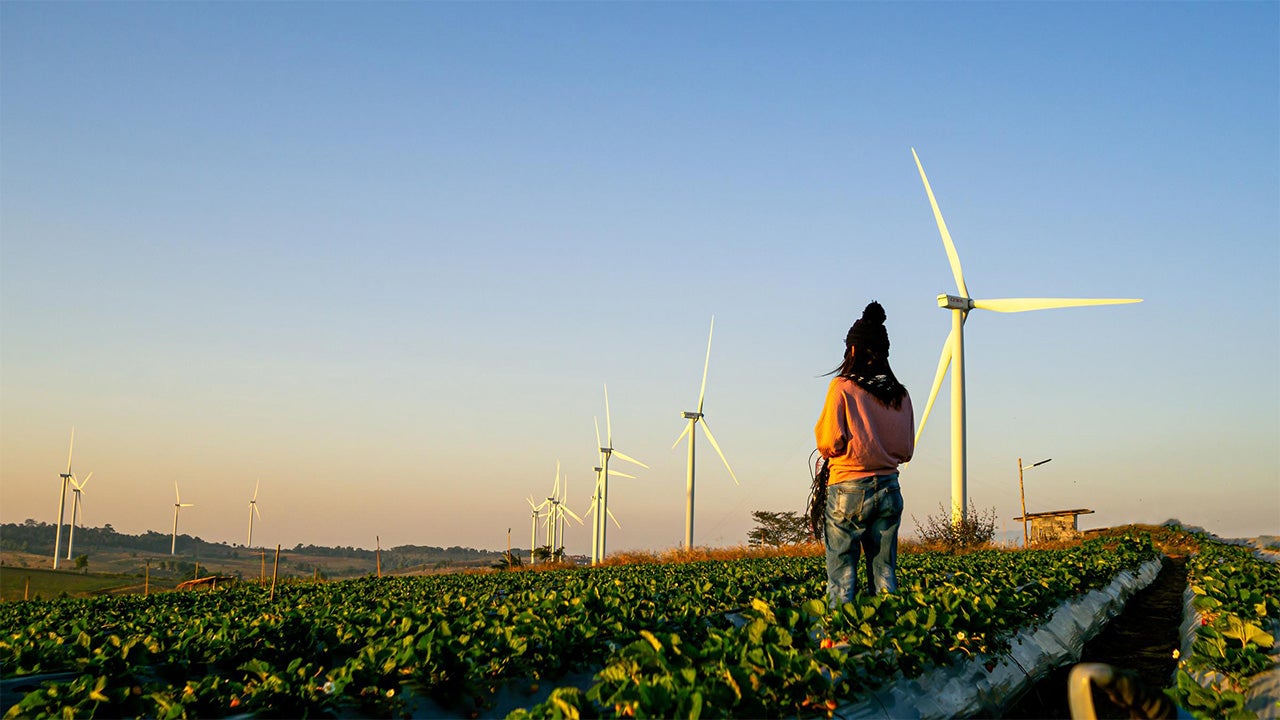Emerging markets are critical for the green energy transition

The world has seen many energy transitions over the past few centuries, from biomass to coal to oil to natural gas. But we believe that the current energy transition, from fossil-based energy to renewable or clean energy production, could prospectively drive the largest capital expenditure boom in history — and fuel opportunities for investors.
According to the International Energy Agency (IEA), non-fossil fuel sources supplied 19% of the world’s total energy needs in 2021, up from 13% in 1973. That trend is accelerating due in large part to two forces: The recent growth in electric vehicles (EV) and the shift toward renewable power generation over coal- and gas-fired generation.
- The electricity generation sector represents 25% of greenhouse gas emissions globally. Decarbonizing the sector from fossil fuel sources to renewable ones would have a major impact on the UN’s emission reduction goal. Additionally, the EU, US, China, and others have stated targets on the share of electricity required to come from renewable sources or on reducing greenhouse gas emissions by 2030.
- Multiple forces should propel the electric vehicle adoption rate across the world in the coming decade, in our view. Additionally, stated targets on the share of electricity required from renewable sources would require significant spending.
The role of copper in the green energy transition
We expect the growth in EVs and the shift toward renewable power generation will drive demand for metals. This is important, as many emerging markets are home to key metals that are critical for the green energy transition. Lithium, nickel, and cobalt have seen increased demand related to EV batteries. However, we believe copper, one of the oldest metals mined, may play a critical role in the new age of energy transition and is less appreciated by the market:
- The average EV contains up to four times the copper as a traditional internal combustion engine vehicle.
- The massive build-out of charging infrastructure that’ll accompany the EV proliferation also requires large amounts of copper.
- Solar and wind power generation are far more copper intensive than traditional thermal power generation. According to IEA, each megawatt of solar power generation uses 2.8 tons of copper versus 1.1 tons for a megawatt of coal and gas power generation.
- As renewable power generation becomes a larger part of the electricity supply, we expect it to change the geographics of our power transmission and distribution networks. New power stations tend to be located in more remote areas, which will require a revamp of the networks that carry and distribute the electricity. Copper will likely be in critical demand as those networks reorganize and expand.
The supply of copper is unlikely to keep up. Copper mines are exceptionally complex and time-consuming to develop due to the required permitting and evaluation processes. It can take up to a decade to complete a mine project. Based on current production plans, energy data and analytics provider Wood Mackenzie expects annual copper production to decline by 1.2% a year between 2023 and 2030 as the productivity of existing mines declines and new supply fails to fully replenish that decline.
The world would have a copper supply shortfall of 5.3 million tons per year by 2033 if no new copper mines were sanctioned. In order to incentivize new projects, we need to have higher copper prices to bring previously uneconomical deposits into production. We believe copper will be a key ingredient of the energy transition movement.
Growth opportunities in EM copper producers
One of our strategy’s holdings is a leading copper producer that we believe is unique from a few perspectives:
- Differentiated geographical exposure. It operates copper mines in Mexico and Peru instead of Chile, where most large copper miners have exposure.
- Unique portfolio of mines that are exceptionally productive. The group’s cash cost in producing copper was the lowest among global copper miners.
- The largest copper reserve in the world among any listed copper producer. It is expected that this company can mine for the next 50 years without any additional exploration efforts.
We believe copper will be a key ingredient of the energy transition movement. This portfolio holding, with its low-cost production and large reserves along with a portfolio of future growth projects, should benefit from copper’s expanded role in the future, in our view.
Investment risks
There is no guarantee that forecasts will come to pass.
All investing involves risk, including the risk of loss.
The value of investments and any income will fluctuate (this may partly be the result of exchange rate fluctuations) and investors may not get back the full amount invested.
Many products and services offered in technology-related industries are subject to rapid obsolescence, which may lower the value of the issuers.
The risks of investing in securities of foreign issuers, including emerging market issuers, can include fluctuations in foreign currencies, political and economic instability, and foreign taxation issues.
In general, stock values fluctuate, sometimes widely, in response to activities specific to the company as well as general market, economic and political conditions.




